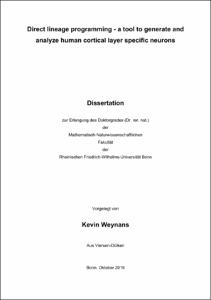Weynans, Kevin: Direct lineage programming - a tool to generate and analyze human cortical layer specific neurons. - Bonn, 2020. - Dissertation, Rheinische Friedrich-Wilhelms-Universität Bonn.
Online-Ausgabe in bonndoc: https://nbn-resolving.org/urn:nbn:de:hbz:5-58485
Online-Ausgabe in bonndoc: https://nbn-resolving.org/urn:nbn:de:hbz:5-58485
@phdthesis{handle:20.500.11811/8371,
urn: https://nbn-resolving.org/urn:nbn:de:hbz:5-58485,
author = {{Kevin Weynans}},
title = {Direct lineage programming - a tool to generate and analyze human cortical layer specific neurons},
school = {Rheinische Friedrich-Wilhelms-Universität Bonn},
year = 2020,
month = may,
note = {Until recently, lineage commitment and differentiation have been considered to be unidirectional and irreversible. This traditional view has dramatically changed with the advent of cellular reprogramming and direct cell fate conversion. Today, almost any given somatic cell can, in principle, be efficiently transferred into any other desired cellular phenotype. These techniques offer great opportunities to generate tissue specific cells, which were so far not easily accessible in human. The human brain, which is equipped with almost incomparable complexity, certainly is the most prominent example for such a tissue. The human cortex for instance is composed of a 6-layer structure, and each layer contains specific neuronal subtypes subserving distinct functions. The behavior of the cortical neurons can be disrupted in developmental disorders including lissencephaly, a cortical malformation associated with defects in neuronal migration and maturation.
In this thesis we use transcription factor-based direct conversion techniques, for the generation of cortical subtype-specific neurons from human induced pluripotent stem cell (iPSC) and human fibroblasts and utilize the derived neurons to investigate phenotypic changes associated with lissencephaly. In more detail, we identified a TF, which is sufficient to induce a deep layer corticofugal fate in cortical differentiated iPSC and in human fibroblasts. When generating induced corticofugal neurons (CiNs) from lissencephaly patients and healthy controls, we observed a decrease in neuronal complexity. In particular, we found significantly reduced neuronal branching in patient-derived CiNs. We suggest that two microRNAs, which are heterozygous deleted in the patient samples, play a role in the observed phenotypic changes. Gain- and loss-of-function studies in patient- and control-derived CiNs confirmed a role of both microRNAs in the disease phenotype. Finally, we identified microRNA downstream pathways involved in neuronal branching to be dis-regulated specifically in patient-derived CiNs.
Our data indicate that direct programming serves as promising technique for the generation of cortical layer specific human neurons and the analyses of neuronal behavior in vitro.},
url = {https://hdl.handle.net/20.500.11811/8371}
}
urn: https://nbn-resolving.org/urn:nbn:de:hbz:5-58485,
author = {{Kevin Weynans}},
title = {Direct lineage programming - a tool to generate and analyze human cortical layer specific neurons},
school = {Rheinische Friedrich-Wilhelms-Universität Bonn},
year = 2020,
month = may,
note = {Until recently, lineage commitment and differentiation have been considered to be unidirectional and irreversible. This traditional view has dramatically changed with the advent of cellular reprogramming and direct cell fate conversion. Today, almost any given somatic cell can, in principle, be efficiently transferred into any other desired cellular phenotype. These techniques offer great opportunities to generate tissue specific cells, which were so far not easily accessible in human. The human brain, which is equipped with almost incomparable complexity, certainly is the most prominent example for such a tissue. The human cortex for instance is composed of a 6-layer structure, and each layer contains specific neuronal subtypes subserving distinct functions. The behavior of the cortical neurons can be disrupted in developmental disorders including lissencephaly, a cortical malformation associated with defects in neuronal migration and maturation.
In this thesis we use transcription factor-based direct conversion techniques, for the generation of cortical subtype-specific neurons from human induced pluripotent stem cell (iPSC) and human fibroblasts and utilize the derived neurons to investigate phenotypic changes associated with lissencephaly. In more detail, we identified a TF, which is sufficient to induce a deep layer corticofugal fate in cortical differentiated iPSC and in human fibroblasts. When generating induced corticofugal neurons (CiNs) from lissencephaly patients and healthy controls, we observed a decrease in neuronal complexity. In particular, we found significantly reduced neuronal branching in patient-derived CiNs. We suggest that two microRNAs, which are heterozygous deleted in the patient samples, play a role in the observed phenotypic changes. Gain- and loss-of-function studies in patient- and control-derived CiNs confirmed a role of both microRNAs in the disease phenotype. Finally, we identified microRNA downstream pathways involved in neuronal branching to be dis-regulated specifically in patient-derived CiNs.
Our data indicate that direct programming serves as promising technique for the generation of cortical layer specific human neurons and the analyses of neuronal behavior in vitro.},
url = {https://hdl.handle.net/20.500.11811/8371}
}






